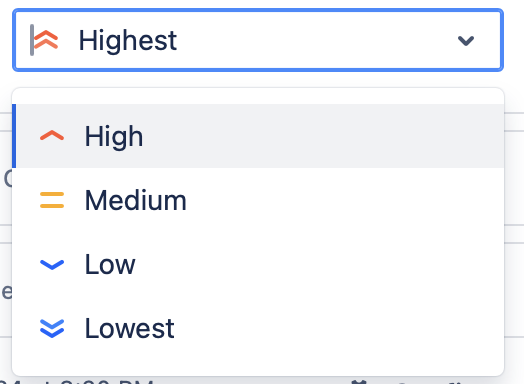Out of the box, Jira offers up five different priorities for any given ticket, which implies five different classes of service. Since the option is there, many teams will use all of them at different times.

A class of service reflects the fact that we behave differently for each. That we give more focus and attention to a high priority item than we do to a lower priority item.
The five Jira priorities that we get out of the box are:
- Highest
- High
- Medium (the default)
- Low
- Lowest
Let’s assume that we use all five because realistically, if the option is there then people will use it.
It’s reasonable to assume that most items will be the default (Medium) and will stay there. Given that, what’s the likelihood that we’ll ever do Low or Lowest priority items? If we’re honest with ourselves, it’s unlikely that we’ll ever run out of Medium items so the Low and Lowest items should starve for attention.
That begs the question of why we ever allowed a Low or Lowest priority items to even move onto the board in the first place. Why would we ever start it, if we know we’ll never give it any attention? Clearly we shouldn’t so those two are redundant and could be safely removed.
Yet, when we look at data from actual teams, we see that Low and Lowest items do get started, even when they haven’t run out of Medium items. What does that tell us about how we use priorities? It means we largely ignore them; we treat them as hints, not rules.
In fact, if we graph cycletimes across priorities, we see that the more priorities are in use, the less difference they seem to make. When we only have two priorities, we can clearly see that the higher priority items get done faster than the lower priority ones. When we have five, it’s very difficult to see any correlation between priority and time to complete.
So what do I recommend instead? Have only two priorities: standard and expedited. If it’s a standard priority then treat all work first-in, first-out. Older items are more important than younger items. If it’s expedited then it’s more important than any standard item so do that first. If you have multiple expedited items then do them in first-in, first-out order as well.
Having only two levels reduces all the complexity, while still giving us a way to boost an item that needs it. The vast majority of items should be normal priority.
Of course, even having two priorities doesn’t solve all the problems. We’ll still have situations where what we say doesn’t match our actions. If an item is expedited then we should be jumping on it and doing it first, yet we routinely see things marked as expedited and then everyone working on other non-expedited work instead.
That’s like an ambulance on the highway putting its lights and sirens on and then stopping to let other people pass it. Behaviours need to match labels; if the lights are on, it should be moving before anyone else. If we mark an item as expedited, we need to do it before anything else.
